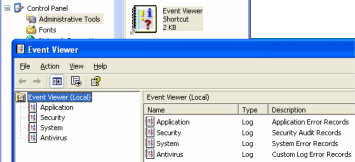You’re happily working along with your computer and suddenly the screen flashes, the computer or application stops, an error message flashes on the screen, and everything comes to a screeching halt and/or your system restarts. But, what was that error?
After the system restarts you may be able to find out by looking in the system Event Log.
Not many people know that events like the above are often captured by the system just before it goes into never-never land. Not only that, but there is an event log viewer located in the Administrative Tools section of the Control Panel…

Open the Control Panel from the Start Menu. Open the Administrative Tools. There you should see an applet called Event Viewer. Double click on it and it opens to show a number of different event categories (this procedure is the same in Windows XP and Vista). In the left panel pick the category most likely to contain the particular error you encountered. The right panel should then show the recorded events in that category with the latest events at the top of the list.
Note that not all of the events listed are going to be errors; indeed, most will not be. A fair number of different events get recorded by Windows all the time.
When you find an event or error you think is the one you are looking for double click on that entry in the log. An Event Properties dialog box should open and show you the details relating the the event or error.
To be honest there is a good chance you will not understand what you are seeing in the error details (and Computer Knowledge can’t catalog every possible error or event out there!). However, often you can determine the specific program that failed and/or the module that program was using. Sometimes there will be a link in the error message. If you click on the link you will be sending the associated information to Microsoft. A dialog should ask you if you want to do that. If you click on the No button the material won’t be sent however your system may (this does not happen with all systems) open a Help window with some specifics about the particular event/error and maybe even a link to Microsoft Knowledgebase articles relating to that event/error.
Hopefully, with this information, you can come to some resolution of whatever problem you had or are having.